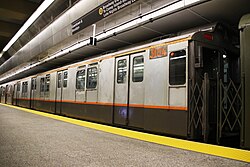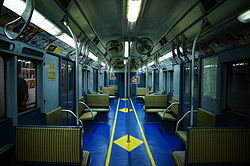R10 (New York City Subway car)
| R10 | |
|---|---|

R10 car 3184 at 96th Street on the Train of Many Metals.
|
|

Interior of an R7A car that was used as the prototype for the R10
|
|
| In service | 1948-1989 |
| Manufacturer | American Car & Foundry |
| Constructed | 1948–1949 |
| Entered service | 1948 |
| Refurbishment | 1984–1986 |
| Scrapped | 1983–1984, 1988–1995 |
| Number built | 400 |
| Number preserved | 2 |
| Number scrapped | 398 |
| Formation | Single units |
| Fleet numbers |
1948–1970: 1803–1852 and 3000–3349 1970–1989: 2950–2974, 3000–3049, 3100–3224 (WH); 2975–2999, 3050–3099, 3225–3349 (GE) |
| Capacity | 56 (seated) |
| Operator(s) |
NYC Board of Transportation New York City Transit Authority |
| Specifications | |
| Car body construction | LAHT Carbon steel |
| Car length | 60.3 ft (18.38 m) |
| Width | 10 ft (3.05 m) |
| Height | 12.2 ft (3.72 m) |
| Platform height | 3.76 ft (1.15 m) |
| Doors | 8 sets of 50 inch wide side doors per car |
| Maximum speed | 55 mph (89 km/h) |
| Weight | 81,200 lb (36,832 kg) |
| Traction system |
General Electric cars: GE PCM type 17KG116A switch group, with 17KC76A1 master controller, using GE 1240-A3 motors (100 hp or 75 kW each). All four axles motorized. Westinghouse cars: WH ABS type UP-631-A switch group, with XM-179 master controller, using Westinghouse 1447-A motors (100 hp (75 kW) each). All four axles motorized. |
| Power output | 100 hp (75 kW) per traction motor |
| Acceleration | 2.5 mph/s (4.0 km/(h⋅s)) |
| Auxiliaries | Edison B4H (32 Volt) battery with 24 cells. |
| Electric system(s) | 600 V DC Third rail |
| Current collection method | Top running Contact shoe |
| Braking system(s) | WABCO SMEE Braking System |
| Coupling system | WABCO H2C |
| Track gauge | 4 ft 8 1⁄2 in (1,435 mm) standard gauge |
The R10 was the first series of post-war New York City Subway cars. They were built by the American Car and Foundry Company from 1948 to 1949 for the IND/BMT B Division.
The R10s were originally numbered 1803–1852 and 3000–3349. Cars 1803-1852 were renumbered 2950–2999 in 1970.
The R10s introduced many innovations. For the first time, the car body was of an all-welded low-alloy high tensile (LAHT) steel construction. This gave the body great strength, as the body and underframe were welded together to form a single, durable and rigid car body which had strong structural integrity. The R10s also featured a new type of braking system known as the "SMEE" schedule braking, which introduced dynamic braking. Dynamic braking reduced wear and tear on brake shoes, reducing maintenance costs. Improved propulsion, in the form of four 100 horsepower (75 kW) traction motors design instead of the traditional two 190 hp (140 kW) motors (the setup used in the Arnines) improved acceleration from 1.75 mph per second to the current 2.5 mph/s. They also featured roofline side destination signs, an arrangement that drew criticism. The R10s were also the first subway cars to incorporate roller bearings instead of the standard friction bearings found on all older railway stock, as well as being the last subway cars ordered with air-operated door engines. Additionally, the R10s were the first subway cars to be equipped with air horns, as opposed to air whistles found on all pre-war subway cars. Finally, the cars introduced the General Steel Industries cast steel truck frame design also used on many passenger cars and coaches up until the R68As in 1989. Sealed beam headlights were installed on all cars of this class starting in 1956.
These cars were nicknamed Thunderbirds by their operating personnel and rail fans because of the cars' high speeds.
Although the R10s could operate in mixed consists of later SMEE cars, the R10s for the most part ran in solid consists throughout their careers, although they were briefly mixed with R16s in the late 1950s when fifty R16s cars were assigned to the A, and the R42s assigned to the A line during 1969-1970.
...
Wikipedia
